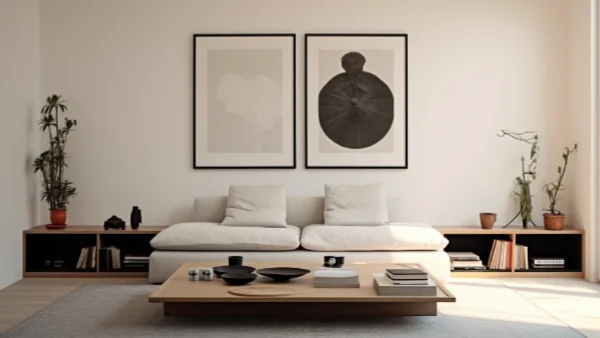
> Feeling burnt out? Subscribe to my Everyday Self-Care Newsletter for self-care tips and doable habits that support your well-being.
Introduction
Welcome to the first step towards a cleaner, more organized home. Decluttering isn’t just about getting rid of things; it’s about creating space for what truly matters to you. This process can seem overwhelming at first, but with a bit of planning and some determination, you’ll find it’s entirely achievable. Think of it as clearing out the unnecessary to make room for peace and productivity in your living spaces. You don’t need any special skills or tools to start; just a willingness to let go of items you no longer need or use. By the end of this guide, you’ll have a clearer space and a better understanding of how to keep it that way. So, ready to declutter your life Let’s get started.
Step 1: Set Clear Decluttering Goals
Before you start pulling items out of closets or emptying drawers, take a moment to think about what you want to achieve. Do you aim to create more space in your living room? Are you looking to reduce the clutter in your kitchen to make cooking easier? Or perhaps your goal is to organize your home office to boost your productivity. Whatever your reasons, having clear goals will help you stay focused and motivated throughout the decluttering process.
Write down your goals and be as specific as possible. Instead of a broad aim like “I want a cleaner house,” try for something more targeted, such as “I want to clear the spare room to create a home office.” This specificity will make it easier to plan your approach and measure your progress.
Remember, these goals are for you, so they should reflect what’s important in your life and home. With your objectives in hand, you’ll be better equipped to tackle the clutter and make decisions about what stays and what goes.
Step 2: Create a Decluttering Checklist
With your goals set, the next step is to make a checklist. This isn’t just any list; it’s your roadmap for decluttering each area of your home. Start by breaking down your goals into smaller, manageable tasks. For example, if your aim is to declutter your kitchen, your checklist might include tasks like “sort through utensils,” “organize the pantry,” and “declutter the countertop.”
Go room by room and list what needs to be done in each. This approach not only keeps you organized but also gives you a clear sense of direction. As you complete each task, check it off. This simple act of marking tasks as done can be incredibly satisfying and motivating.
Your checklist will also help you identify what supplies you might need, such as storage bins or shelf organizers. Having everything you need before you start will make the process smoother and quicker.
This checklist is your personal tool, so tailor it to suit your needs. Whether it’s detailed or just a series of bullet points, what matters is that it helps you move towards your decluttering goals.
Step 3: Tackle One Room at a Time
Starting the decluttering process can feel overwhelming, especially if every room needs attention. The key is to focus on one room at a time. This method keeps the task manageable and helps prevent burnout. Choose a starting point that makes sense for you. Some prefer to begin with the easiest room to quickly see progress, while others might choose the most cluttered area to get it out of the way.
Once you’ve picked your starting room, stick with it until it’s completely decluttered. Resist the temptation to jump from one room to another without finishing the first. This focused approach ensures that you’re not spreading your efforts too thin and actually see results in one area before moving on to the next.
As you work through each room, use the checklist you created in Step 2 to guide your efforts. This will help you stay on track and ensure that no corner is overlooked. After completing a room, take a moment to appreciate your hard work before moving on to the next space. This pause can be refreshing and give you a boost of motivation for the next room on your list.
Step 4: Sort Items into Categories
As you begin to declutter each room, sorting items into categories is a practical step to keep things organized. This means grouping like items together so you can see exactly what you have, which helps in making decisions on what to keep, donate, or throw away. For instance, gather all your books in one spot or collect all the kitchen gadgets to sort through.
Create categories that make sense for the items you have. Common categories include things like clothing, books, kitchenware, and paperwork, but feel free to customize this based on what’s in your home. You might have categories for sports equipment, craft supplies, or seasonal decorations.
This sorting process makes it easier to evaluate what you really need and use. You might discover duplicates or items you forgot you had. When everything is laid out by category, it simplifies the decision-making process because you can clearly see the volume of items in each category and assess their relevance and utility in your life.
After sorting, you’ll be in a better position to decide which items should stay and which should go. This step is crucial for creating an organized space that supports your daily life without being overrun by unnecessary clutter.
Step 5: Apply the 6-Month Rule
A simple yet effective strategy in the decluttering process is the 6-month rule. This guideline suggests that if you haven’t used an item in the past six months, it’s likely you don’t need it and can let it go. Of course, this rule has exceptions, such as seasonal items or special occasion wear, but it generally applies well to most categories of belongings.
As you sort through your items, ask yourself when you last used each one. If the answer is more than six months ago, consider whether it’s something you truly need or if it’s just taking up space. This rule helps to cut down on the “just in case” mentality that leads to clutter accumulation.
For items that are harder to part with, think about their actual utility in your life. Is there someone else who could get more use out of them? Could donating or selling the item feel better than holding onto it unused? Applying the 6-month rule not only helps in reducing clutter but also in making thoughtful decisions about what to keep in your living space.
This step is about being honest with yourself about what you really use and need. It’s a helpful way to minimize your belongings to those that add value to your daily life.
Step 6: Organize as You Go
As you work through decluttering each room and sorting items into categories, it’s a good idea to organize them as you go. This means finding a proper place for the things you decide to keep. Doing this step by step with each category not only helps you keep track of what you’ve sorted through but also gradually transforms your space into a more organized and functional area.
Start by deciding on a home for each item or group of items you’re keeping. Think about where and how you use these things to determine the best spot for them. For example, cooking utensils should be easily accessible in the kitchen, and workout gear might be best kept near where you exercise.
Use storage solutions that fit your space and your items. Shelves, bins, and drawer organizers can all be helpful tools in keeping your belongings neatly stored. Labeling boxes or shelves can also make it easier to find things later on.
Organizing as you go also allows you to immediately see the benefits of your decluttering efforts. Each organized space is a step towards a more orderly home. This not only makes it easier to find and use your possessions but also creates a more peaceful living environment.
Keep in mind, the goal is to have a designated spot for everything. This way, you can avoid future clutter by knowing exactly where to put things away.
Step 7: Find a Home for Everything
Once you’ve decluttered and decided what to keep, the next step is to ensure everything you’ve chosen to hold onto has its own place. This is crucial for maintaining the orderliness of your home and avoiding the buildup of clutter in the future. Assigning a specific spot for each item makes it easier to find what you need when you need it and simplifies the process of putting things away after use.
Start by looking at the items you use daily. These should be the most accessible, ideally stored in locations that are easy to reach and near where they are used. For items used less frequently, consider storing them in less accessible spots, such as higher shelves or in storage rooms.
Be creative with your storage solutions. Use boxes, baskets, hooks, and shelves to maximize your space and keep things organized. If you’re short on space, look for under-utilized areas, like under the bed or above cabinets, for additional storage options.
Labeling storage containers can also be a big help, especially for items that aren’t used often. This way, you won’t have to open every box to find what you’re looking for.
The goal is to have a designated place for every item, making it easy to keep your home tidy and reducing the time spent looking for misplaced things. This step not only contributes to a more organized home but also supports a smoother daily routine.
Step 8: Implement Storage Solutions
After finding a home for each item, the next step is to bring in storage solutions that help keep everything organized. Choosing the right storage can make a big difference in how functional and tidy your space feels. Whether it’s adding shelves, using bins, or installing hooks, the right storage solutions can help maximize your space and keep your belongings accessible yet out of sight.
Consider what types of items you’re storing and select storage options that suit them best. For example, clear bins might be perfect for craft supplies or seasonal decorations, allowing you to see inside without opening them. Drawer dividers can work wonders for keeping clothes or office supplies neat.
Also, think vertically. Shelves and hanging systems can provide extra storage space by utilizing walls, freeing up floor space. If you’re limited on space, look for multifunctional furniture, like ottomans with storage or beds with built-in drawers.
When implementing storage solutions, keep ease of use in mind. You’re more likely to keep things organized if it’s easy to put them away. For items you use frequently, opt for open baskets or shelves that don’t require moving other items to access what you need.
Finally, personalize your storage to fit your lifestyle and decor. Storage isn’t just functional; it can also be an aesthetic addition to your home. Choose colors and styles that complement your space, making your storage solutions a seamless part of your home’s design.
Step 9: Maintain a Decluttering Routine
After putting in the hard work to declutter and organize your home, maintaining that state is key. Developing a routine helps prevent clutter from building up again. Think of it as regular upkeep for your home, much like cleaning or doing laundry.
Start by setting aside a little time each week to go through your belongings and decide if there’s anything else you can part with or if anything has been misplaced. This doesn’t have to be a long process; even 15 to 30 minutes can make a big difference.
Be mindful about what you bring into your home. Before acquiring new items, ask yourself if they are necessary and where they will go. This cautious approach helps avoid unnecessary clutter.
Also, consider adopting a one-in-one-out rule. When you bring a new item into your home, find something old to donate or discard. This practice helps keep your belongings at a manageable level and ensures that everything you have serves a purpose.
Finally, involve your household in maintaining the decluttered space. Share your organizing system with them and make it a team effort to keep the home tidy. This not only eases the burden on you but also fosters a shared responsibility for the space you all enjoy. By incorporating these habits into your daily life, you’ll be able to enjoy a clutter-free home for the long term.
Step 10: Celebrate Your Decluttered Space
After all your hard work decluttering and organizing, take a moment to appreciate your efforts. Your space is now more functional and peaceful, thanks to your dedication. It’s important to acknowledge the progress you’ve made and enjoy the benefits of your decluttered home.
Consider taking before and after photos of your space to visually see the difference. This can be incredibly satisfying and serve as motivation to maintain your new, clutter-free environment.
You might also want to celebrate by inviting friends or family over to enjoy your refreshed space. Sharing your success with others can make the accomplishment feel even more rewarding. Alternatively, enjoy a quiet evening in your decluttered home, doing something you love. The peace and tranquility of your organized space can enhance your relaxation and enjoyment.
Remember, decluttering isn’t just about getting rid of things; it’s about creating a home that supports your lifestyle and well-being. By reaching this step, you’ve done just that. So, give yourself a pat on the back for a job well done. Your effort has transformed your home into a more pleasant and welcoming space.


